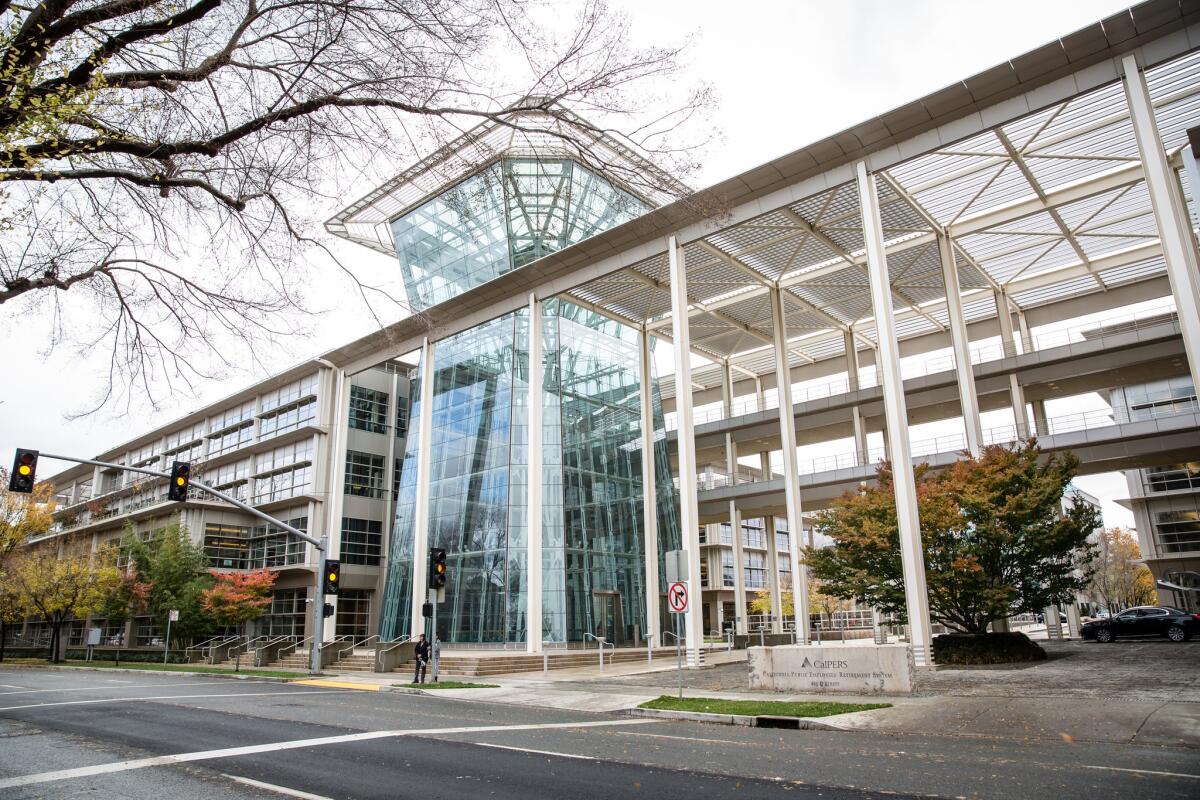Editorial: CalPERS needs to play it safer

The California Public Employees’ Retirement System (CalPERS) building on November 3, 2014 in Sacramento.
- Share via
To pay the retirement benefits owed to more than 1.7 million current and former public employees, the California Public Employees’ Retirement System should have about $410 billion stashed away. Today, however, the pension fund is holding less than $300 billion, thanks in no small measure to the losses incurred after the housing bubble burst and Wall Street cratered.
That’s one reason the CalPERS board of governors voted last week to make an actuarial change that will require state and local governments to contribute more to the fund, while allowing the system to pursue a less risky and more reliable investment strategy. The change — a reduction in the projected annual returns on the fund’s investments — will be phased in to make it easier for cash-strapped local governments to adjust, with contribution rates bumping up in years when the economy is likely to be strong.
The move was long overdue, but the board may not be moving fast enough.
The move was long overdue, but the board may not be moving fast enough.
How much the roughly 3,000 public employers that participate in CalPERS have to pay into the fund each year depends on two main factors: the projected cost of the benefits owed, and the expected earnings of the fund’s investments. (Under state and federal law, employers can’t force current or former workers to contribute more to their pensions if investments don’t meet expectations.) The larger the expected earnings, the less employers are asked to contribute to the fund. A higher level of expected earnings also makes the benefits offered seem less expensive to government employers and taxpayers.
Once the fund’s actual investment earnings fall behind, however, a high level of expected earnings makes it that much harder to catch up. CalPERS, for example, has assumed that it will earn 7.5% annually. In the fiscal year that ended June 30, it fell about $21-billion short of that. To pull even again, it would have to earn almost twice as much on its investments this year — an unlikely outcome. That’s why CalPERS remains in a deep hole despite having gangbuster returns on its investments in four of the five years after the housing crash. And though CalPERS has averaged a 7.8% return over the last 20 years, that’s no guarantee of future results. Indeed, many economists have been predicting slower U.S. and global growth in the first half of the 21st century than in the last half of the 20th, making the investment gains of previous decades unlikely in the years to come.
CalPERS had already reduced its expected rate of return from 7.75% per year in 2012 to 7.5%, a change that forced participating governments to hike their contributions considerably. On Wednesday, the board agreed to cut the figure again to 6.5%, but in incremental steps in a process that will probably take 20 years.
The longer CalPERS banks on high returns, the longer it will need to continue making higher-risk investments for the sake of an outsized payoff. With risk comes volatility, as seen when the pension fund went from a 16% return in fiscal 2014 to 2% in fiscal 2015. That’s why Gov. Jerry Brown urged CalPERS to reduce its expected returns to 6.5% over five years, not 20 or more.
CalPERS resisted Brown’s proposal because it would raise pension costs sharply for governments; for example, the state’s annual contribution alone would increase from about $4.7 billion to $6.7 billion before declining. But pensions are a pay-me-now-or-pay-me-later obligation, and covering more of the cost early on can save money in the long run. Just as important, clinging to overly optimistic earnings assumptions hides the real cost of the benefits offered. And if a city can’t pay that bill when it ultimately comes due, its only options are grim ones, including slashing its workforce, eliminating services and, in the worst case, cutting pensions through bankruptcy.
No one wins under those scenarios. The Legislature should take advantage of the state’s current flush coffers to pay down its unfunded pension liability on a faster timetable than CalPERS has proposed, and cities that can afford to do so should do the same. If the markets around the world defy expectations and CalPERS’ pension fund enjoys a sustained boom, governments will reap the savings down the road. But if the years of 7.5% and higher growth are indeed over, it’s better to adapt now before the hole grows too deep.
Follow the Opinion section on Twitter @latimesopinion and Facebook
More to Read
A cure for the common opinion
Get thought-provoking perspectives with our weekly newsletter.
You may occasionally receive promotional content from the Los Angeles Times.









